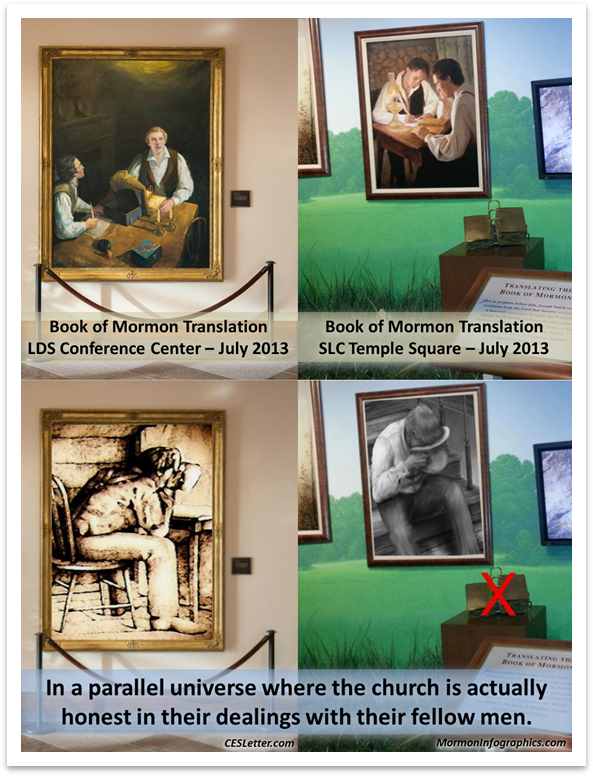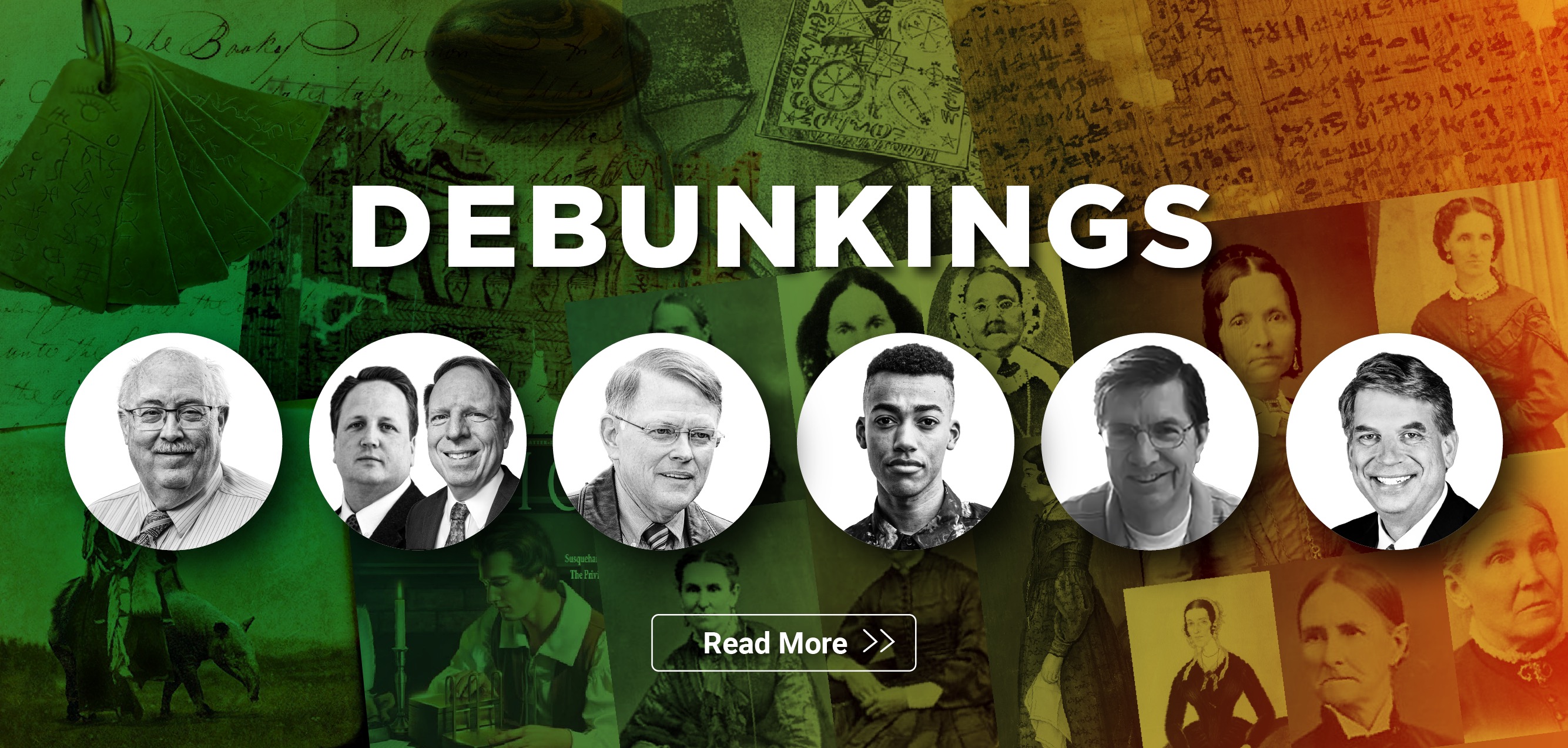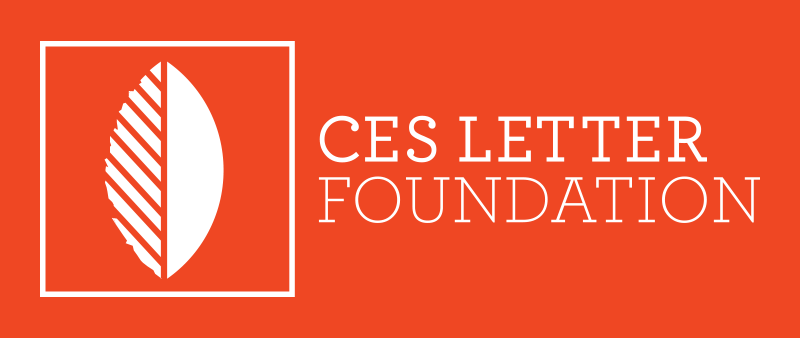Detailed Response
Kinderhook Plates
Kinderhook Plates
Mormon Infographic titled "Kinderhook plates: History of the Line of Ham or Hoax?"
Correct:
The graphic is correct, but it is useful to know the actual source of the quote used by History of the Church. It should be noted that the graphic includes a portion of a quote from History of the Church that is written as if it came from Joseph Smith:
“I insert fac-similes of the six brass plates found near Kinderhook, in Pike county, Illinois, on April 23, by Mr. Robert Wiley and others, while excavating a large mound. They found a skeleton about six feet from the surface of the earth, which must have stood nine feet high. The plates were found on the breast of the skeleton and were covered on both sides with ancient characters. I have translated a portion of them, and find they contain the history of the person with whom they were found. He was a descendant of Ham, through the loins of Pharaoh, king of Egypt, and that he received his kingdom from the Ruler of heaven and earth.”
The quote in question was written in William Clayton's journal. It was rewritten in the first person (as if Joseph Smith had said it himself) when it was included in History of the Church. Clayton's journal is the primary source, which was used in History of the Church (a secondary source).
The quote by William Clayton is indeed accurate: Joseph Smith did attempt to translate a portion of the Kinderhook Plates. This is explained in the following section.
Quotes to consider:
The following is from Stanley B. Kimball, "Kinderhook Plates Brought to Joseph Smith Appear to Be a Nineteenth-Century Hoax," Ensign, August 1981:
These two oblique references to a “translation” were followed thirteen years later by a more direct published statement that until recently was wrongly thought to have been written by Joseph Smith himself. On September 3 and 10, 1856, the following paragraphs appeared in the Deseret News as part of the serialized “History of Joseph Smith”:
“[May 1, 1843:] I insert fac similes of the six brass plates found near Kinderhook, in Pike county, Illinois, on April 23, by Mr. R. Wiley and others, while excavating a large mound. They found a skeleton about six feet from the surface of the earth, which must have stood nine feet high. The plates were found on the breast of the skeleton, and were covered on both sides with ancient characters.
“I have translated a portion of them, and find they contain the history of the person with whom they were found. He was a descendant of Ham, through the loins of Pharaoh, king of Egypt, and that he received his kingdom from the ruler of heaven and earth.” (Then followed a reprint of material from the Times and Seasons article.)
Although this account appears to be the writing of Joseph Smith, it is actually an excerpt from a journal of William Clayton. It has been well known that the serialized “History of Joseph Smith” consists largely of items from other persons’ personal journals and other sources, collected during Joseph Smith’s lifetime and continued after the Saints were in Utah, then edited and pieced together to form a history of the Prophet’s life “in his own words.” It was not uncommon in the nineteenth century for biographers to put the narrative in the first person when compiling a biographical work, even though the subject of the biography did not actually say or write all the words attributed to him; thus the narrative would represent a faithful report of what others felt would be helpful to print. The Clayton journal excerpt was one item used in this way. For example, the words “I have translated a portion” originally read “President J. has translated a portion..."
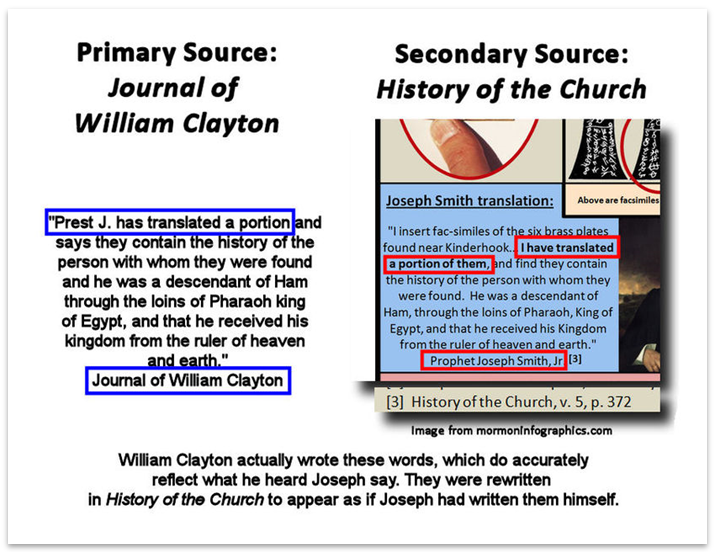
FairMormon deleted their above response. See screenshot.
Jeremy's Response
FairMormon's primary points are:
- Joseph Smith did indeed translate the fake 19th-century Kinderhook Plates.
- The translation claimed that the fake 19th century Kinderhook Plates contained:
- William Clayton’s journal entry is correct in stating that Joseph Smith translated the Kinderhook Plates.
- The following Kinderhook Plates Mormon Infographic is correct:
"…the history of the person with whom they were found. He was a descendant of Ham, through the lions of Pharaoh, the king of Egypt, and that he received his kingdom from the rule of heaven and earth.”
I disagree with FairMormon's phrasing of “Joseph Smith did attempt to translate a portion of the Kinderhook Plates.” Joseph didn’t attempt anything. Joseph actually translated a portion of the Kinderhook Plates, as stated in the History of the Church and in William Clayton’s journal. It is clear that Joseph translated a portion of the fake Kinderhook Plates as opposed to “attempting” to translate:
"I have translated a portion of them, and find they contain the history of the person with whom they were found. He was a descendant of Ham, through the loins of Pharaoh, king of Egypt, and that he received his kingdom from the Ruler of heaven and earth."
- History of the Church, Volume 5, Page 372 - emphasis added
Even scholar Don Bradley, who is the architect of the new Kinderhook Plates theory that FairMormon is basing their response on, agrees that Joseph provided a translation of the Kinderhook Plates:
He [Joseph Smith] did provide a bit of translation. Despite the attempts to deny this by Stanley Kimball and others, the evidence points decidedly in that direction. William Clayton did not acquire his information about Joseph and the Kinderhook plates from the rumor mill. Clayton was Joseph’s personal secretary, and a man as much in his confidence as any at the time. He dined with Joseph at the Mansion House, examined the plates while there, and traced one of them on the reverse of the page where he recorded his journal entry for the day, including this regarding the plates, ‘Brother Joseph has translated a portion of them, and says they contain...’
– Mormon Apologetics Forum, April 18, 2007
To add to Don Bradley’s statement, the loss of William Clayton’s journals and records would have been catastrophic to the Church’s history; especially of its Nauvoo period. There were no doubts about William Clayton or his record of Joseph Smith’s translation of the Kinderhook Plates until science proved in 1980 that the Kinderhook Plates were a 19th-century hoax. Only then did Mormon apologists start throwing William Clayton under the bus in order to distance the prophet from the damage and fraud.
The graphic notes that Joseph claimed to have translated a portion of the Kinderhook plates, and that "they contain the history of the person with whom they were found. He was a descendant of Ham, through the loins of Pharaoh, king of Egypt, and that he received his kingdom from the Ruler of heaven and earth."
Correct:
As William Clayton noted in his journal, Joseph "translated a portion" of the Kinderhook plates. Joseph attempted to translate one of the characters on the plates by matching it to a similar character on the Grammar and Alphabet of the Egyptian Language (GAEL), a document that was produced in the same timeframe as the Book of Abraham. It is from the GAEL that he derived the "descendant of Ham, through the loins of Pharaoh" meaning.
This data was introduced by Don Bradley at the 2011 FairMormon Conference. For a detailed explanation, see Don Bradley “‘President Joseph Has Translated a Portion’: Solving the Mystery of the Kinderhook Plates,” 2011 FairMormon Conference.
FairMormon deleted their above response. See screenshot.
Jeremy's Response
It blows my mind that FairMormon is using the Grammar and Alphabet of the Egyptian Language (GAEL) as support for their new theory for the Kinderhook Plates.
For decades, Mormon apologists have tried to discredit and diminish the GAEL due to its damage to Joseph’s Book of Abraham translation claims. They blamed Joseph’s scribes for the GAEL, claimed it had little influence on Joseph, and did everything they could to distance the Prophet from the GAEL; especially since we can now read Egyptian and even more especially after the Book of Abraham papyri were rediscovered in 1966. The papyri contain the same hieroglyphic characters that are also included in the GAEL, which establishes that the Book of Abraham was translated using both the papyri and the GAEL. The reason why Mormon apologists tried to distance the Prophet from the GAEL is because the GAEL is, according to every respectable LDS and non-LDS Egyptologist who studied it, pure gibberish nonsense. None of them will defend or rationalize the GAEL.
Let’s take a look at the character FairMormon claims Joseph translated and which he felt compelled to announce that the fake plates “contain the history of the person with whom they were found. He was a descendant of Ham through the loins of Pharaoh, King of Egypt, and that he received his Kingdom from the ruler of heaven and earth.”

Jeremy's Response

Well, that's a problem. So, what does FairMormon do? They "deconstruct" it...
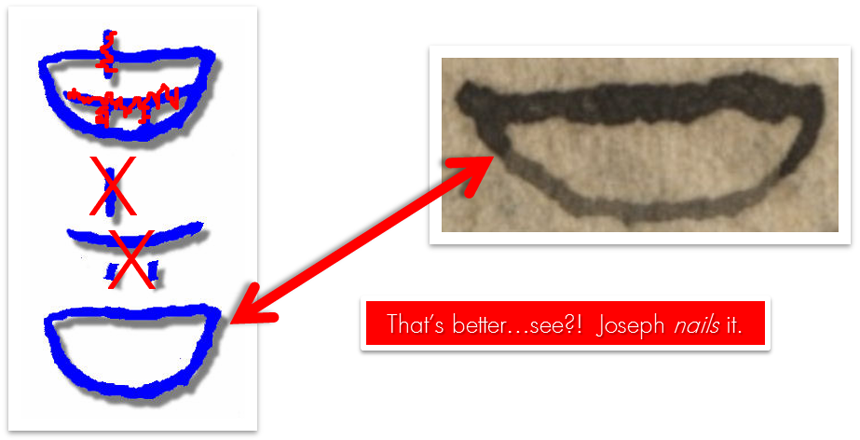
Egyptian hieroglyphics do not translate into paragraphs. The above boat shaped figure does not translate into an entire sentence or paragraph. In fact, a boat shaped hieroglyphic such as the one above represents only two consonants in the Egyptian language: “nb”
Anyone who seriously thinks that a single Egyptian hieroglyphic, let alone one which represents two consonants, translates into:
Ha e Oop Hah - honor by birth, kingly power by the line of Pharaoh, possession by birth; one who reigns upon his throne universally…possessor of heaven and earth and of the blessings of the earth
…either does not understand the Egyptian language or is deliberately making stuff up. They do not understand how its phonology (consonants, vowels, phonotactics), grammar (nouns, verbs, adjectives), and syntax works.
Mormon apologist, Hugh B. Nibley, concurs:
One needs no knowledge of Egyptian to point out that a dot and two strokes can hardly contain the full message of an English paragraph of a hundred words or more. – Meaning of the Kirtland Egyptian Papers
While I applaud FairMormon and Don Bradley for reversing decades of Mormon apologetics by finally acknowledging that Joseph Smith did indeed translate a portion of the Kinderhook Plates, it is a stretch – to say the least – that this “deconstructed” character legitimizes or validates the situation. It’s a stretch to push an unsubstantiated theory that Joseph simply did a “secular” translation and therefore he’s off the hook.
Even if FairMormon's theory is true and Joseph did a secular translation of the plates based on a character that somewhat resembles (only after a bit of deconstructing) a character in the GAEL, the secular-translation argument is simply unbelievable. There is no evidence that Joseph Smith considered the Kinderhook Plates translation a secular translation. Moreover, there is no precedent for Joseph Smith claiming to have made secular translations of events relating to ancient Biblical or Book of Mormon history. Joseph Smith never caveated his translations by saying that they were secular only, and it is unreasonable to have expected him to do so. Indeed, such a caveat clearly would have been important enough for Joseph’s personal scribe William Clayton to note when he recorded the description of Joseph Smith’s translation.
Contrary to thinking Joseph Smith’s translation was secular, the Church, until the Kinderhook Plates were revealed as a hoax in 1980, trumpeted the Kinderhook Plates translation as evidence of Joseph Smith’s divine ability to translate ancient documents.
Moreover, the GAEL does not account for the assertion that the dead person with whom the plates were found was also the author. This assertion must have come from some other source. Where? Some other secular source?
Joseph was simply off the mark. He got it wrong. If Joseph can be so wrong about a 19th-century hoax while claiming it’s ancient and that it’s so-and-so who was descended from so-and-so, how do we know that Joseph didn’t likewise make stuff up with the keystone Book of Mormon? The Book of Abraham?
At the end of the day? The Kinderhook Plates is a 19th-century hoax, the GAEL is gibberish nonsense, and Joseph not only mistranslated the fake plates but he legitimized the hoax as an ancient record…all while failing to discern the fraud.
In other words, Joseph did not merely say that the Kinderhook plates were authentic; he went much further than that – he described their contents.
Like the Book of Abraham, Joseph Smith failed the test as a translator.
The graphic states that "Joseph didn't discern the fraud. The LDS Church now concedes it's a hoax. What does this tell us about Joseph Smith's gift of translation?"
- FairMormon agrees that Joseph didn’t discern the fraud and that the LDS Church now concedes the Kinderhook Plates are a 19th-century hoax.
- FairMormon disagrees that Joseph used his “gift of translation”. FairMormon claims that Joseph’s translation of the fake Kinderhook Plates was “secular.”
An eyewitness stated that Joseph compared the Kinderhook plates with the Egyptian Alphabet and Grammar. The translation produced supports this. He did not attempt to translate using his "gift of translation."
Quotes to consider
From Don Bradley, "'President Joseph Has Translated a Portion’: Solving the Mystery of the Kinderhook Plates":
"[T]he [Kinderhook] plates are evidently brass, and are covered on both sides with hieroglyphics. They were brought up and shown to Joseph Smith. He compared, in my presence, with his Egyptian Alphabet,” Now, the guys a non-Mormon here, and so he doesn’t actually understand what this Egyptian Alphabet is. So he says, “which he took from the plates which the Book of Mormon was translated,” but he doesn’t know it’s from the Book of Abraham papyrus, he says, “He compared, in my presence, with his Egyptian Alphabet…and they’re evidently the same characters. He therefore will be able to decipher them.” So this is the Alphabet and Grammar volume, and you can see the title on the spine says “Egyptian Alphabet.” Now, Robin Jenson, of the Joseph Smith papers tells me that we don’t know when this label was added, it could have been added in Utah. If it was added early on, then this “gentile” would have seen this on the spine and obviously would have called it the “Egyptian Alphabet.” Even if it is a later name that is affixed to it, it shows what the Saints actually knew this volume as, they knew it as “Egyptian Alphabet.” So that is likely the name under which he would have heard of it.
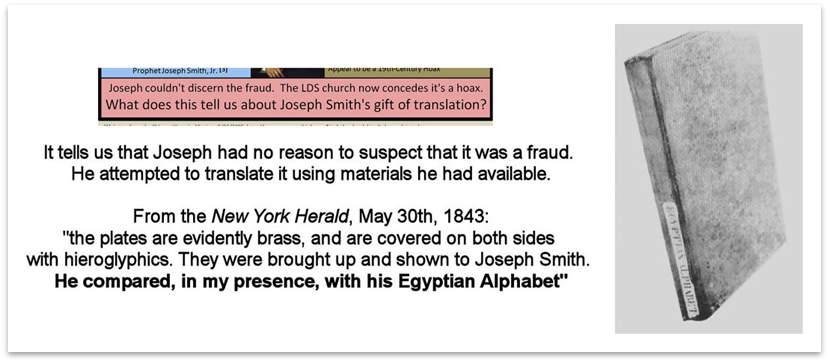
FairMormon deleted their above response. See screenshot.
Jeremy's Response
This is incorrect. Here is the rest of the quote of the May 30th, 1843 New York Herald article which FairMormon omits from their readers in their graphic:
“The plates were evidently brass, and are covered on both sides with hyerogliphics [sic]. They were brought up and shown to Joseph Smith. He compared them in my presence with his Egyptian alphabet, which he took from the plates from which the Book of Mormon was translated, and they are evidently the same characters.”
- The New York Herald, May 30, 1843
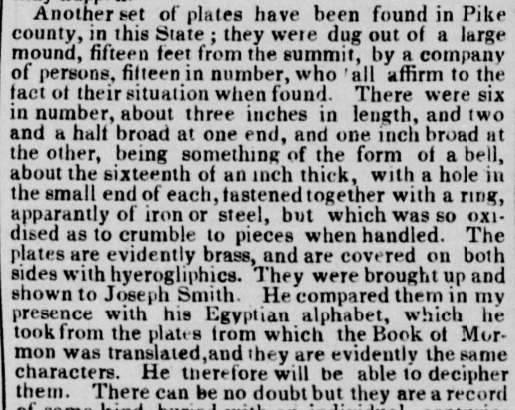
Well, isn’t that interesting? It's clear why FairMormon omitted the last part of the sentence from their graphic.
This quote from the New York Herald was posted by an anonymous “Gentile.” It is the equivalent of today’s anonymous blog post comment. This anonymous quote is FairMormon’s linch-pin for their new Kinderhook Plates theory.
FairMormon wants you to believe that this “non-Mormon” Gentile is incorrect in stating that the “hyerogliphics” were taken “from the plates from which the Book of Mormon was translated”. FairMormon says that this non-Mormon was mistaken and that he really meant the Grammar and Alphabet of the Egyptian Language (GAEL) instead.
In other words, this Gentile may very well have been talking about the Book of Mormon “Caractors” but we’re going to change and reinterpret his statement to have meant the GAEL in order to make our new Kinderhook Plates theory work.
Indeed, the key piece of the puzzle here that FairMormon is not presenting to their readers is the Charles Anthon transcript (“Caractors” document below). Joseph copied several lines of Egyptian hieroglyphics from the gold plates, which as the story goes, Martin Harris took to New York to present to Charles Anthon for his opinion on the authenticity of the characters and the translation.
Here is the document that represents the Book of Mormon characters on the gold plates:

Book of Mormon Witness David Whitmer, who once owned the document, said it was this text that Martin Harris showed to Charles Anthon. Encyclopedia of Mormonism continues:
However, this claim remains uncertain because the transcript does not correspond with Anthon’s assertion that the manuscript he saw was arranged in vertical columns. Even if the document is not the original, it almost certainly represents characters either copied from the plates in Joseph Smith’s possession or copied from the document carried by Harris. Twice in late 1844, after the Prophet’s martyrdom, portions of these symbols were published as characters that Joseph Smith had copied from the gold plates – once in broadside and once in the December 21 issue of the Mormon newspaper The Prophet.
Joseph had a copy of the Book of Mormon “Caractors” which he was showing off to others in Nauvoo around the time of the Kinderhook Plates. One person whom Joseph showed the above “Caractors” to was Reverend George Moore. Moore wrote in his dairy:
Called on the Prophet Joseph Smith. His carriage was at the door and he was about going away, but he received me very kindly, asked me into his house. I remained about 10 minutes. He was very communicative. We conversed about the golden plates, which he professes to have dug up and translated into the Book of Mormon...He showed me some specimens of the hieroglyphics, such as, he says were on the gold plates... – Diary of George Moore, Tuesday, December 20, 1842, p.105-105
So, why does this matter? It matters because Joseph Smith was parading around and showing others the Egyptian hieroglyphics he copied off the gold plates around the same time as the discovery of the Kinderhook Plates. This is consistent with the New York Herald’s non-Mormon’s account of “which he took from the plates from which the Book of Mormon was translated, and they are evidently the same characters,” which refers to Joseph’s copy of the hieroglyphics from the gold plates.
FairMormon's reinterpretation of this non-Mormon’s words to mean the GAEL when the non-Mormon’s “which he took from the plates from which the Book of Mormon was translated” clearly refers to the Anthon transcript – or Joseph’s own personal document which he copied the hieroglyphics from the gold plates – is unfounded. The reason why FairMormon is insisting that this non-Mormon referred to the GAEL is because their reinterpretation of the quote is the required linch-pin for FairMormon’s new Kinderhook Plates theory.
As for FairMormon’s “deconstruction” of the hieroglyphic from the Kinderhook Plates? We can play this game too using the Anthon transcript.
Allow me to do some of my own “deconstructing”:
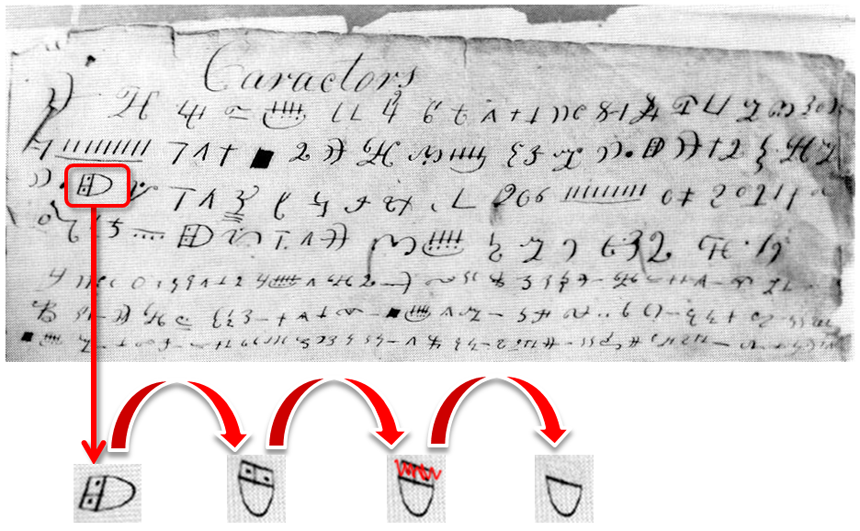

Moreover, if Joseph can still make the claim that he translated – without the “gift of translation” (whatever that means) – what does this say about Joseph’s integrity? About his claim of being a translator of ancient documents? About his modus operandi of translating? About the Book of Mormon? About the Book of Abraham?
The GAEL is nonsense. The Kinderhook Plates are fake. There is no indication that Joseph believed anything other than that both were legitimate and real. Why then should we believe Joseph? What credibility does Joseph have for his claims?
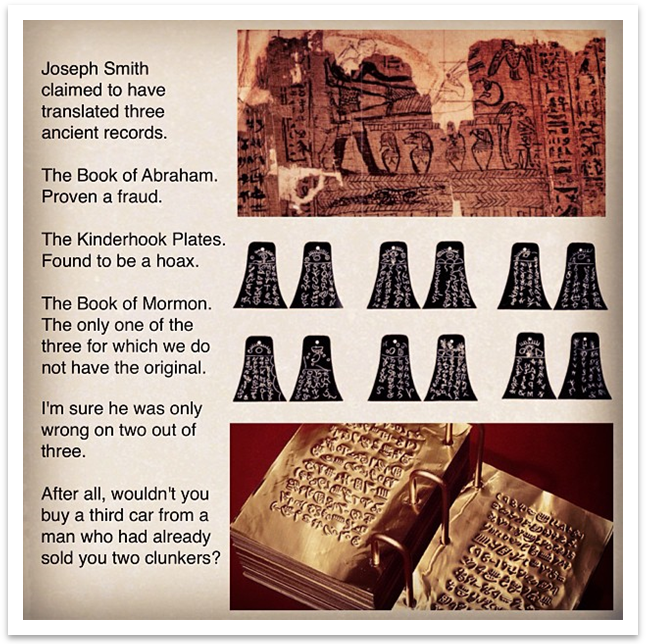
Joseph Smith made a scientific claim that he could translate ancient documents
"Joseph Smith made a scientific claim that he could translate ancient documents. This is a testable claim. Joseph failed the test with the Book of Abraham. He failed the test with the Kinderhook Plates."
The author got one fact incorrect:
Joseph Smith did not make a "scientific claim" that he could translate ancient documents. He claimed that he could translate ancient documents by the "gift and power of God."
The author himself notes a perceived incompatibility between religion and science when he claims that, "The problem Mormonism encounters is that so many of its claims are well within the realm of scientific study, and as such, can be proven or disproven. To cling to faith in these areas, where the overwhelming evidence is against it, is willful ignorance, not spiritual dedication." Yet, he claims that Joseph Smith made a "scientific claim" that he could translate.
FairMormon deleted their above response. See screenshot.
Jeremy's Response
FairMormon fails to include the sentence that comes after this sentence in the CES Letter: "This is a testable claim."
This is just FairMormon banging pans over semantics. I use the words "scientific" and "testable" interchangeably. I'm not saying that Joseph himself directly stated that he's making a "scientific claim". I'm saying that by claiming to be able to translate ancient Egyptian and ancient documents, he has made testable claims.
Joseph's "translations" in the Facsimiles are testable. We can read what they actually say. Joseph's "translation" of the Book of Abraham is a testable claim. We have the papyri and we can read Egyptian now. Joseph's "translation" claim of the Kinderhook Plates is testable now. We know that the Kinderhook Plates are a hoax and we have Joseph's "translation" of the fake plates.
I have updated the sentence in the CES Letter to clarify my interchangeable use of the words "scientific" and "testable":
Joseph Smith made a claim that he could translate ancient documents. This is a testable claim. Joseph failed the test with the Book of Abraham. He failed the test with the Kinderhook Plates.
The Book of Mormon
"I’m now supposed to believe that Joseph has the credibility of translating the keystone Book of Mormon? With a rock in a hat? That the gold plates that ancient prophets went through all the time and effort of making, engraving, compiling, abridging, preserving, hiding, and transporting were useless? Moroni’s 5,000 mile journey lugging the gold plates from Mesoamerica (if you believe the unofficial apologists) all the way to New York to bury the plates, come back as a resurrected angel, and instruct Joseph for 4 years only for Joseph to translate instead using just a…rock in a hat?"
- FairMormon brings up the irrelevant Nephite interpreters (aka “Urim and Thummim”) when it wasn’t even used for translating the Book of Mormon we have today.
- FairMormon agrees that gold plates were not used for translating the Book of Mormon but offers unsubstantiated opinions on what its purpose instead was.
The Nephite interpreters consisted to two stones mounted in a set of "spectacles." Contemporary accounts indicate that Joseph actually placed the "spectacles" in his hat, to block out external light.
He eventually switched to using his own seer stone, which he also placed in a hat.
FairMormon deleted their above response. See screenshot.
Jeremy's Response
The Nephite interpreters (also called “Urim and Thummim”) were not used for the Book of Mormon we have today. They are irrelevant. They were removed from Joseph after Martin Harris lost the 116 pages. This is FairMormon’s attempt to obfuscate and mislead their readers into thinking that the Nephite interpreters were used for translating the Book of Mormon we have today, which is incorrect.
Here’s what Book of Mormon witness David Whitmer said:
[H]e used a stone called a “Seers stone,” the “Interpreters” having been taken away from him because of transgression. The “Interpreters” were taken from Joseph after he allowed Martin Harris to carry away the 116 pages of Ms [manuscript] of the Book of Mormon as a punishment, but he was allowed to go on and translate by use of a “Seers stone” which he had, and which he placed in a hat into which he buried his face, stating to me and others that the original character appeared upon parchment and under it the translation in English. – An Address to All Believers in Christ, 1887, p.13
"He eventually switched to using his own seer stone, which he also placed in a hat.”
Correct. When he did is also very important. He switched after the loss of the 116 pages and when he started working on what is today’s Book of Mormon.
What is this “seer stone” that FairMormon mentions? It’s a “magical” rock that Joseph Smith found in 1822 while digging a well on his neighbor William Chase’s property. This was a year before Moroni showed up in Joseph’s bedroom and 5 years before obtaining the gold plates. Its origin and use was for occult, treasure hunting, and “glass looking” activities before Joseph whipped them out for the Book of Mormon translation.
Neither revelatory instrument required a view of the plates. The interpreters were not "glasses" that somehow converted the characters on the plates into English, which, in reality, wouldn't be any easier to believe. So, what is the difference?
FairMormon deleted their above response. See screenshot.
Jeremy's Response
"So, what is the difference?"
This reminds me of the following meme made by Mormon apologists:
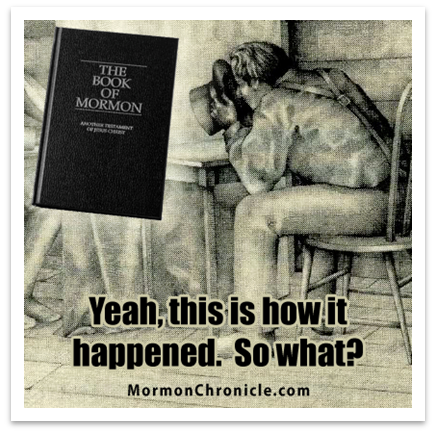
The Book of Mormon was not translated as the Church teaches. So what, right?
Missionaries are being taught and are teaching investigators a complete lie of how the Book of Mormon was translated. So what, right?
Children are being taught in Primary and Young Men/Young Women the lie that gold plates were used for translating the Book of Mormon. So what, right?
Joseph used this same method in conning people out of their money in his treasure hunting days. So what, right?
The arrogant and gaslighting "So what?" condescending sneers from Mormon apologists, especially with the rock and the hat "translation", has been a constant that I've observed over the years in all of my interactions with Mormon apologists.
What's the difference?
- This is not how the Church presents the Book of Mormon translation to its members. Joseph is shown using, handling, reading, and translating the gold plates.
- The Nephite interpreters (aka “Urim and Thummim”) were never used for the Book of Mormon we have today. They were removed from Joseph when Martin Harris lost the 116 pages. Why FairMormon disingenuously refers to the Nephite interpreters (aka “Urim and Thummim”) when they were never used in the actual translation for the Book of Mormon we have today, I don’t know.
- The rock in the hat method was the same method Joseph used to con his customers out of their money when he was running his family’s treasure hunting business. Joseph would place the same “seer stone” in the same hat to tell his customers where to unsuccessfully find buried treasure that he would use a few years later to “translate” the Book of Mormon.
- The rock or “seer stone” was not given to Joseph by Moroni or any divine source. It was a rock that Joseph found while digging a well on his neighbor William Chase’s property in 1822; 1 year before Moroni’s bedroom visit and 5 years before getting the gold plates.
- Even by FairMormon’s own admission, the plates were not used for translating the Book of Mormon.
Can you imagine the confusion, bewilderment, shock, and disgust of believing Chapel Mormons - learning for the first time in their lives - listening to a Sunday School lesson or Sacrament talk or even Elder Holland sharing in General Conference about how Joseph did not use the gold plates for translating the Book of Mormon after all?
That Joseph was channeling sentences off his treasure hunting rock in his hat instead? A rock that Joseph found digging in his neighbor’s backyard in 1822? A year before Moroni showed up in Joseph’s bedroom? 5 years before he obtained the gold plates?
That the purpose of the gold plates was served not in the translation process but rather as “proof to the witnesses that an ancient record actually existed”?
I can think of no better concise and succinct statement about the core issue of the rock and the hat Book of Mormon translation problem and the Church's decades of hiding and covering this up than this:
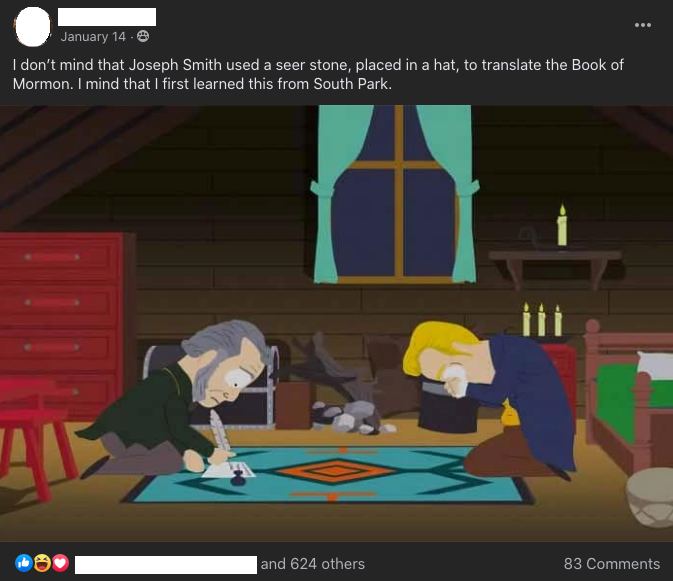
In November 2003, the best place to learn about how the Book of Mormon was really translated was not from the LDS Church but from South Park. Here's the relevant part from South Park's November 2003 "All About Mormons" episode (Season 7 - Episode 12):
Here's some comments from the same above Facebook post screenshot talking about this issue:

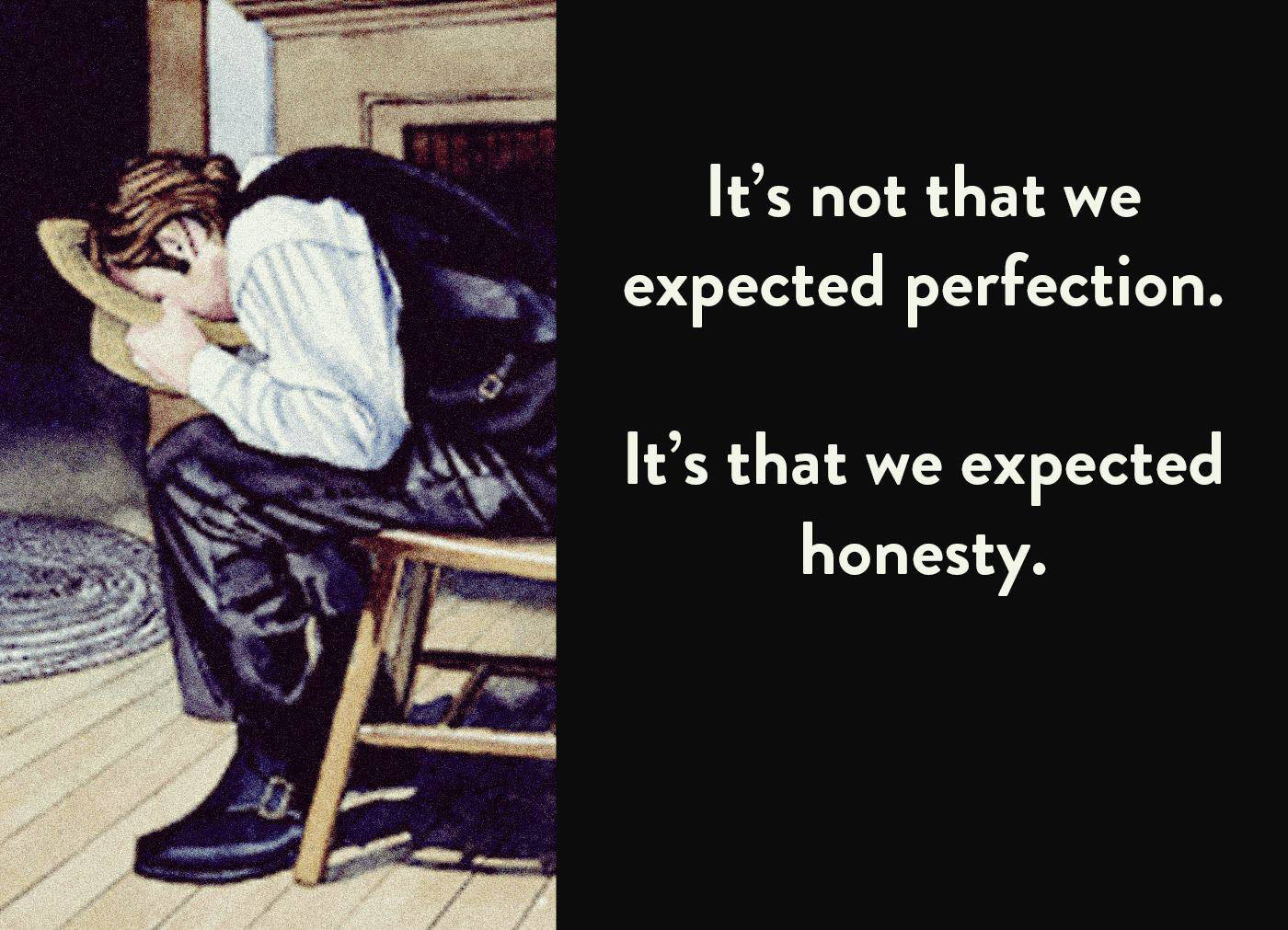
The plates served as proof to the witnesses that an ancient record actually existed, and they testified of this.
Quotes to consider:
Contemporary newspaper accounts talking of the placement of the spectacles in the hat:
[A]nd after penetrating “mother earth” a short distance, the [Golden] Bible was found, together with a huge pair of spectacles! He had been directed, however, not to let any mortal being examine them, “under no less penalty” than instant death! They were therefore nicely wrapped up and excluded from the “vulgar gaze of poor wicked mortals!” It was said that the leaves of the bible were plates of gold, about 8 inches long, 6 wide, and one eighth of an inch thick, on which were [Page 131] engraved characters or hyeroglyphics. By placing the spectacles in a hat, and looking into it, Smith could (he said so, at least,) interpret these characters. (“Golden Bible,” Rochester Advertiser and Daily Telegraph (New York, 31 August 1829). Reprinted from Palmyra Freeman, 11 August 1829.)
[H]e proceeded to the spot, and found the bible, with a huge pair of spectacles....He is said to have shown some of these characters to Professor Samuel L. Mitchell, of this city, who could not translate them. Martin Harris returned, and set Joseph Smith to the business of translating them: who, “by placing the spectacles in a hat and looking into them, Joseph Smith said he could interpret these characters.” (C. C. Blatchley, “Caution Against the Golden Bible,” New-York Telescope 6/38 (20 February 1830), 150.)
FairMormon deleted their above response. See screenshot.
Jeremy's Response
"The plates served as proof to the witnesses that an ancient record actually existed, and they testified of this.”
This is one of many examples of how different FairMormon's version of Mormonism is from correlated Chapel Mormonism. Gold plates used for translating the Book of Mormon? Nope.
Ancient prophets went through all that hassle of engraving, compiling, abridging, preserving, hiding, and transporting the gold plates so that Joseph’s 19th-century New England treasure-hunting-magical-thinking Mormon family and friends would believe Joseph’s stories as legit.
I address FairMormon’s pet theories and philosophies of men mingled with scripture on the purpose of the gold plates here.
